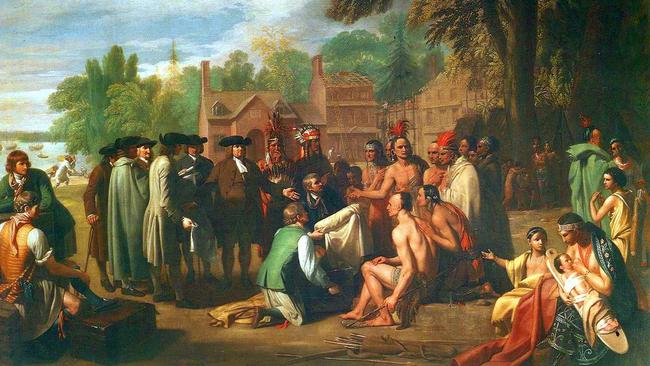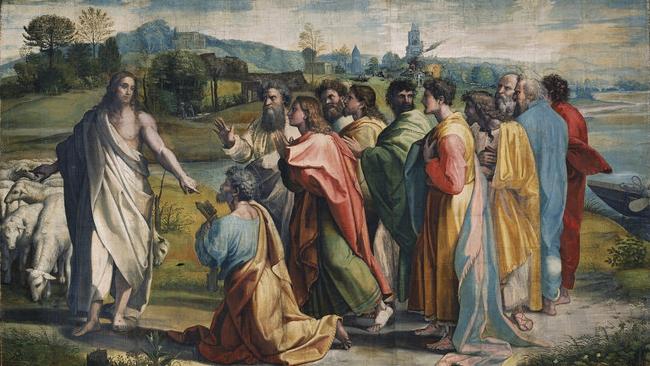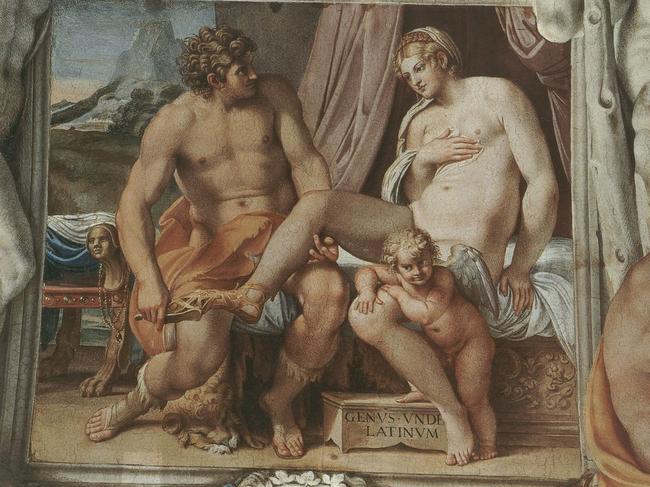Christopher Allen’s art history series: dimensions of human experience
The human shape is central to historical pictures.

In the late 1830s, after the conclusion of the deadly Black Wars of the 20s, an otherwise obscure colonial painter called Benjamin Duterrau felt impelled to commemorate the conciliation brought about by George Augustus Robinson with the few remaining Tasmanian Aborigines. Considering the ferocity of the conflict on both sides, its conclusion was certainly a significant event, and Duterrau set about painting what he called a National Picture.
Duterrau’s final work, more than 3m x 4m, is lost, although it may still survive and Stephen Scheding recounted his hunt for it in The National Picture (2002). Fortunately the artist also produced a scaled-down version of the composition, known as The Conciliation (1840), which is in the collection of the Tasmanian Museum and Art Gallery in Hobart and was the centrepiece of a remarkable exhibition mounted at the National Gallery of Australia in Canberra, co-curated by Tim Bonyhady and Greg Lehman, and reviewed here in July 2018.
In undertaking this project, Duterrau must have been thinking of the relatively recent precedent of Benjamin West’s Penn’s Treaty with the Indians (1771-72), which is today in the Pennsylvania Academy of the Fine Arts collection in Philadelphia. Readers can find the work on its website, but there is a much better reproduction of it on the Wikipedia page.
West, born in the American colonies, moved to London soon after painting the treaty picture, and became the second president of the Royal Academy after Joshua Reynolds. Duterrau, although not originally trained as a painter, had exhibited at the academy during the years of his presidency and in any case would have been familiar with West’s extensively published oeuvre.

But the most important frame of reference for understanding a work such as this is the genre to which it belongs. I discussed the concept of genre last week, and mentioned some of those traditionally regarded as lesser and more specialised, such as portraiture and still life. A painting such as The Conciliation, though certainly a provincial and awkward production, nonetheless belongs to what was held to be the grandest and most ambitious of genres, history painting.
The category is not found explicitly in ancient sources: whereas several fundamental works of literary theory, including in the fields of poetics and rhetoric, survived from antiquity, there was not a single work of art theory. Renaissance theorists found inspiration in these literary treatises, as well as surviving biographical and technical material in Pliny’s Natural History and elsewhere, and drew on architectural theory in Vitruvius’s De architectura, originally published in the time of Augustus.
Nor did the concept arise at once in any prescriptive form, let alone as part of the hierarchy of genres later enshrined in academic theory. Leon Battista Alberti, whose De pictura (1435) is the foundational text of modern art theory, simply uses the term historia to mean a narrative painting. But many of the suggestions he makes, some extrapolated from anecdotes in Pliny, become enduring principles in later theoretical writing.

The primacy of history painting as a genre is implicit rather than explicit in Alberti. Partly it reflects the fact that the famous paintings of antiquity that he mentions, known only from literary sources, are mostly narrative subjects. But the assumption that narrative pictures are inherently more interesting than non-narrative ones is also an expression of the humanistic spirit of the Renaissance: there was nothing more interesting than stories about human life, and even religious stories were recast as events involving real men and women.
So of course is the Renaissance axiom that the painted image should be something like a continuation of the world of visual experience. Alberti himself coined the metaphor of the painting as a window on to the world, but more concretely his theory of perspective is predicated on a continuity of space between the viewer in the real world and the images in the painted one.
A century before Alberti, Giotto had already begun to reshape the assumptions of the art of painting by making his figures look like solid bodies in space. This was far more momentous than a shift in the history of style: it was in fact nothing less than a revaluation of the phenomenal world and a reorientation of our standards of reality.
The medieval mind saw the phenomenal world as ultimately illusory, compared with a reality only fully accessible to the mind of God. At the end of Paradiso, there is a stupendous episode where Dante momentarily glimpses what the universe is really like from God’s point of view, but in a proto-Kantian insight simultaneously recognises that the human mind cannot comprehend that reality. Giotto’s new interest in the phenomenal world, a world of bodies that exist in space, is one of the great examples of an artist articulating a change in the way of thinking that was taking place among his contemporaries: the proto-Renaissance mind was moving from the transcendent to the immanent world, preparing the way for the new model of cognition that we call science.

So the idea of the real was changing. Byzantine artists had sought to evoke an eternal reality that existed, in timeless crystalline form, beyond the world of matter and change: “sages standing in God’s holy fire”, as Yeats said. But the Renaissance wanted to bring even the holy figures, the saints, Christ himself, into this material and phenomenal world to make them vivid and real according to the new standard.
As already mentioned, Alberti’s historia simply means a story. Most of the early subjects of history paintings are scriptural or based on the extensive corpus of traditions about the early saints of the church collected by Jacopo da Voragine in his mid-13th century Legenda aurea (The Golden Legend): in the Scrovegni Chapel, for example, Giotto draws on the gospels for the life of Jesus, but also on The Golden Legend for the episodes in the upper registers devoted to the life of the Virgin.
In the later Brancacci Chapel, Masaccio and his master Masolino take the figures of Adam and Eve from the beginning of Genesis, while other episodes such as The Tribute Money come from the gospels. Piero della Francesca’s Legend of the True Cross cycle at Arezzo takes some episodes and most of its characters from the Old Testament, but its narrative from The Golden Legend.
Other subjects were drawn from history or mythology. Stories about great figures of antiquity such as Caesar or Alexander or others who had been exemplary for their integrity or devotion to their country were popular. Mythological themes are rarely found in large-scale paintings before the latter part of the 15th century, with artists such as Mantegna and Botticelli, and don’t become common until the High Renaissance, when Raphael, for example, decorates the loggia of the Farnesina in Rome with the story of Psyche from Apuleius.
These different sources — religious, historical, mythological — offered artists and their patrons a broad range of subjects through which to ponder various dimensions of human experience, from the spiritual and the moral to the political and even the romantic and erotic. These subjects did not appeal equally to all audiences, for while the scriptural stories were generally understood by all, the historical and mythological subjects were addressed primarily to educated viewers.

Mythology was not, however, an entirely recondite study; thanks to the pervasive influence of astrology on the medieval mind, everyone knew the names of Venus, Mars, Mercury and other gods. And the greatest figures of antiquity, Caesar and Alexander in particular, were at least familiar to all but the most illiterate peasants. Culture was graduated, as it always is, but it was broadly common, and the subjects of art belonged to a corpus that was meaningful and even urgently meaningful to its audience.
We will see in a later piece what happens when those shared cultural references break down — and what happens to the genre of history painting in particular — but the important thing to emphasise is the power of shared stories. There can be quite different collections of stories both within and between cultures: courage, heroism, loyalty, betrayal, passion and heartbreak can be evoked through classical history, ancient legend, medieval romance or the stories of Ferdowsi’s Shahnameh. Shakespeare can express the greatest range of experience in subjects drawn from ancient Rome, from the Wars of the Roses in Britain or even from contemporary history in Othello. But they must be part of a common culture and imagination.
If we return for a moment to Duterrau, we can see that his subject, although perhaps puzzling to a modern audience, would have been a significant one to his regional audience almost two centuries ago. He was trying to create a memorial to the most important, if local, historical event that he had witnessed, and as in all history painting — as in West’s treaty painting or his Death of General Wolfe (1770) — he was trying to bring all the most significant elements of the story together into one painted moment.
Next week I want to discuss the question of expression in greater depth, and here too Duterrau will provide a good starting point.
But there is an even more fundamental aspect of history painting that gave him trouble, and that is the drawing of the figure. Duterrau had not been properly trained as an artist and, for all his many preparatory figure studies, his figure painting never reaches the standard even of a reasonable amateur.
For all narrative pictures are composed of human figures and it is the primacy of history painting that explains the central place of the figure in Western art, both in practice and in pedagogy. It is a very different matter in the Chinese tradition, where landscape is the highest tradition and the human figure is strictly subsidiary. For us, the primacy of narrative painting meant that landscape, as we shall see in a few weeks, had to struggle to emerge quite literally from the background.
The other great influence on the representation of the human figure in modern Western art was the Greek idea of the body as a thing of beauty –— an idea that has so deeply shaped our thinking as to seem almost natural, but that was a conception of the utmost originality, running counter to the mediocrity or ugliness of most real bodies to postulate an ideal body as a metaphor of human dignity.
A whole history of modern art in the past 500 years can be built around the changing representation of the human figure, and the history of art teaching, from Renaissance apprenticeships to the academies of the baroque period and the modern art school, can similarly be understood as the quest for a path between celebrating the beauty of the body and making it play an effective and expressive part in the acting of a narrative.
READ MORE FROM CHRISTOPHER ALLEN: Dante, Proust and Tolstoy: Great literary works you should read | The art of Sydney’s Peter Kingston


To join the conversation, please log in. Don't have an account? Register
Join the conversation, you are commenting as Logout